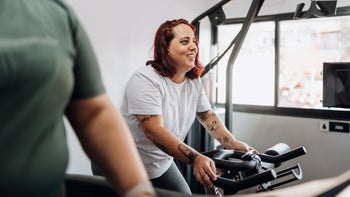
Here’s Why You May Not Be Hungry After a Workout
Key takeaways:
Intense workouts may suppress hunger signals.
Refueling can help replenish your energy stores, even when you’re not hungry after a workout.
Consider nutritious snacks or meals that contain protein and carbs.

You hit the showers after an intense workout. By the time you’re done, you’re still not hungry. You might even wait hours after a workout to eat if hunger is your guide.
Sound familiar? If so, there may be a reason why you're not hungry after a workout. Find out what it is and why you should consider refueling even if your stomach isn’t growling yet.
Why aren’t you hungry after a workout?
There are many physical processes that go into appetite and feeling full. According to the National Library of Medicine, the main feedback loop relies on hormones, especially ghrelin and leptin. These hormones work together to regulate sensations of hunger and satiety. Ghrelin kicks off your hunger signals, and leptin surges when you’ve eaten enough.
Save over 40% on Qsymia with GoodRx
Discover the once daily Qsymia for weight management. Qsymia is for adults and children 12-17 in combination with a healthy diet and regular exercise.

Hormonal shifts can result from several factors, including:
Stress levels
Physical health
Current diet
Age
Sex
Certain medical conditions like thyroid disease or diabetes
Turns out that exercise is on this list, too.
For example, research in the journal Sports Medicine looking at 80 different studies found that exercise can suppress ghrelin production. Researchers noted that the way blood flow changes during a workout could be the culprit here. Whatever the mechanism, the result is that when your ghrelin is suppressed, so is your appetite.
Even with consecutive days of exercise, hunger may not surge to compensate. For instance, one study found that despite more energy expenditure over 2 days, participants didn’t feel hungrier after working out.
Exercise may even suppress appetite, research suggests. Another study found that exercise stimulated a metabolite in the body called N-lactoyl-phenylalanine (lac-phe for short). This metabolite actively tamped down food intake.
Read more like this
Explore these related articles, suggested for readers like you.
Although the study was done on mice and not humans, the researchers noted that the results are likely the same for people because the metabolites and hormonal pathways are similar.
Is it OK to not eat after working out?
While it’s not mandatory to eat after a workout, in general, it’s a good idea even when you’re not hungry.
“Relying only on hunger cues after exercise could be sabotaging your fitness in an inadvertent way,” said Marisa Michael, a registered dietitian nutritionist who specializes in sports nutrition. “That’s because it’s crucial to restore the glycogen you’ve lost during exercise. When you wait too long for that, your muscles aren’t getting what you need, and you may have a longer recovery time postworkout.”
Glycogen is stored carbohydrates. When you exercise –– especially if it’s an intense workout that fatigues certain muscles –– your body uses that glycogen for fuel. After exercising, you’ll basically be running on empty until you refill that tank, Michael noted. If you don’t, it may take longer for your muscles to recover from the workout.
Also, the more intense the workout is, the shorter the time frame should be for that refueling, added registered dietitian Shena Jaramillo.
“There are several variables when it comes to what individuals choose for postworkout foods,” she said. “One of those is exercise duration or intensity. That’s why it’s helpful to plan your postworkout choices in advance, based on the exercise you’re going to do.”
That type of preparation can also help with making sure you’re eating when you should, rather than waiting until you’re hungry. Even if you’re embarking on a low-intensity option, like a long walk, Jaramillo suggested making a plan for eating within 1 to 2 hours after you finish.
How to refuel your body after a workout when you’re not hungry
When planning your postworkout nutrition plan to refuel, Michael said a good guideline is to get about 20 g to 30 g of protein and 30 g to 40 g of carbohydrates. Some options include:
A bowl of brown rice or quinoa with chicken breast
A peanut butter sandwich and a glass of milk
Whole wheat wrap with vegetables and turkey slices
Sweet potatoes with hard-boiled eggs
Greek yogurt with granola
Tuna salad sandwich
Salmon with avocado slices
If you’re really not hungry to the point of resisting the thought of food, Jaramillo said a liquid option can be useful, such as a protein shake or smoothie. Whether you put this together with your own ingredients or you buy a prepackaged option, these should also have a combination of protein and carbs.
Also essential? Rehydration, especially after an intense workout. Even with moderate exercise, not getting enough hydration can hurt your fitness performance and physical health.
The bottom line
Research suggests that exercise can change your hunger signals, and may cut them off completely for at least a few hours. Yet, making sure you refuel after a workout is important for muscle recovery. That’s why you should plan your postworkout foods or protein shakes in advance, so you're not relying on hunger cues to guide you after exercising.
Why trust our experts?



References
Armitage, H., et al. (2022). ‘Anti-hunger’ molecule forms after exercise, scientists discover. Stanford Medicine News Center.
Douglas, J. A., et al. (2015). Appetite, appetite hormone and energy intake responses to two consecutive days of aerobic exercise in healthy young men. Appetite.
Jensen, J., et al. (2011). The role of skeletal muscle glycogen breakdown for regulation of insulin sensitivity. Frontiers in Physiology.
Li, V., et al. (2022). An exercise-inducible metabolite that suppresses feeding and obesity. Nature.
Ouerghi, N., et al. (2021). Ghrelin response to acute and chronic exercise: Insights and implications from a systematic review of the literature. Sports Medicine.
Von Duvillard, S. P., et al. (2004). Fluids and hydration in prolonged endurance performance. Nutrition.
Yeung, A. Y., et al. (2023). Physiology, obesity neurohormonal appetite and satiety control. StatPearls.





























